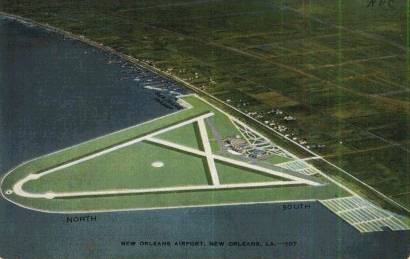|
Today in New Orleans History |
|
|
October 23


Tulane Stadium Opens Ground was broken for Tulane stadium on April 7, 1924. It opened on October 23, 1926
with a seating capacity of roughly 35,000. New Orleans-Item sports editor Fred Digby popularized the term "Sugar Bowl"
in 1927. The first Sugar Bowl game was played there on January 1, 1935, against the Philadelphia Temple Owls. The last
was on December 31, 1974 when Nebraska beat Florida 14-10. In 1947 the stadium was expanded to
accommodate 80,985 fans. Lights were installed in 1957. It was the home of the Saints, from their first game
on September 17, 1967 when John Gilliam returned the opening kickoff 94 yards for a touchdown (but they lost 27-13 loss to
the Los Angeles Rams) until December 8, 1974 when they won 14-0 over the St. Louis Cardinals. On November 8, 1970, Tom Dempsey
made his record-breaking 63-yard field goal there, pushing the Saints into a 19-17 win over the Detroit Lions. The record attendance of
86,598 was set on December 1, 1973, during the last game played by LSU against Tulane in the Sugar Bowl. Tulane defeated LSU
14-0, ending a 25-year winless streak against LSU. The last
game ever played in Tulane Stadium was between De La Salleand Rummel on November 1, 1979. The last point scored in Tulane
Stadium History was by Rummel High place kicker Gary Boudreaux. The stadium was under demolition from November 18, 1979
through June 15, 1980. (Photo by Infrogmation, 1980)
On October 3, 2011, the announcement was made that German automaker Mercedes-Benz purchased
naming rights to the Superdome. The new name took effect on October 23, 2011. The Dome is the third stadium
that has naming rights from Mercedes-Benz (and first in the United States), after the Mercedes-Benz Arena, the stadium of
Bundesliga club VfB Stuttgart, in Stuttgart, Germany and the Mercedes-Benz Arena in Shanghai, China.
Eight years earlier, on February
10, 1934, the airport opened with great fanfare. More than 10,000 visitors from around the world attended the dedication
of what was coined "the Air Hub of the Americas". Built at a cost of $4.5 million, the airport's 3,000 foot-long
field qualified it for the U.S. Department of Commerce's highest rating of AA-I. The architecture was considered a modern
marvel. Everything about the airport was state-of-the-art and first class. It was the first major airport
in the region and the first combined land and seaplane air terminal in the world. And it was named Shushan Airport. Architect Leon C. Weiss designed it (as well as the state capital, the governor's mansion, the Louisiana State
University buildings, and the LSU Medical School. Inside the terminal building were/are beautiful Art Deco appointments as
well as murals by artist Xavier Gonzalez, friezes by Enrique R. Alferez who also carved the Fountain of the Four Winds which
stands out front. Shushan Airport, which had been under construction since 1929, sits adjacent to the
Industrial Canal on a man-made peninsula jutting into the lake. To make land available for this elaborate project, the Orleans
Levee Board drove a 10,000 foot retaining wall into the lake and pumped six million cubic yards of hydraulic fill to raise
the field above the water. It was this project (and others) that landed Shushan, the levee board president, in hot water. On March 27, 1934, Shushan submitted his resignation, citing health reasons. In the letter of resignation
to Governor O.K. Allen he noted accomplishments during his tenure which included a five-and-one-half long "levee"
(along what is now Lakeshore Drive) with an average width of 3500 feet (over one-half mile) for eventual use as residential
and recreational development (this became a part of the Lakeview post-WWII subdivisions of Lake Vista, Lake Terrace, etc.).
Shushan was indicted on October 19, 1934 for eight counts of personal income tax evasion, was tried on October 8, 1935, and
acquitted later that month of those charges. He remained the levee board president, however, because at at subsequent
meetings of the board there were no quorums, therefore, no means of accepting his resignation. He was a slick operator,
to say the least. He said, regarding the tax evasion charges, that he was being persecuted politically. Shushan was released from prison
on parole in September of 1942. On February 28, 1947, President Harry S. Truman granted him a full and unconditional
pardon. Born on January 12, 1894 in Reserve, Abraham Lazar Shushan on died on November 3, 1966
at Touro Infirmary and is buried in Chevra Thilim Cemetery. He was educated in New Orleans and began his career at Shushan
Brothers, a whole-sale dry-goods firm owned by his father and uncle, and later became its president and principal owner.
He had served as levee board president during the terms of four governors (Parker, Fuqua, Long, Allen) who had all appointed
him to the position beginning in 1920. He was a close personal friend of Huey P. Long. Shushan's political clout
enabled constitutional amendments calling for the development of the lakefront to be enacted.
|
|
|

To receive an update for each day in New Orleans history,
join our facebook page - Today in New
Orleans History.
Analytics |

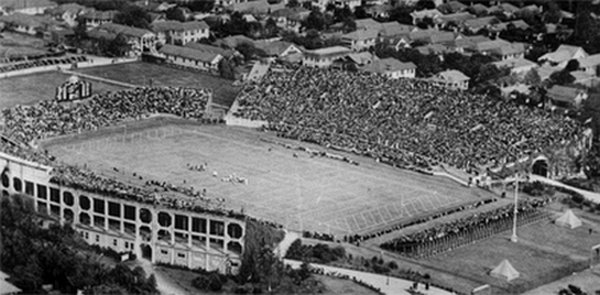
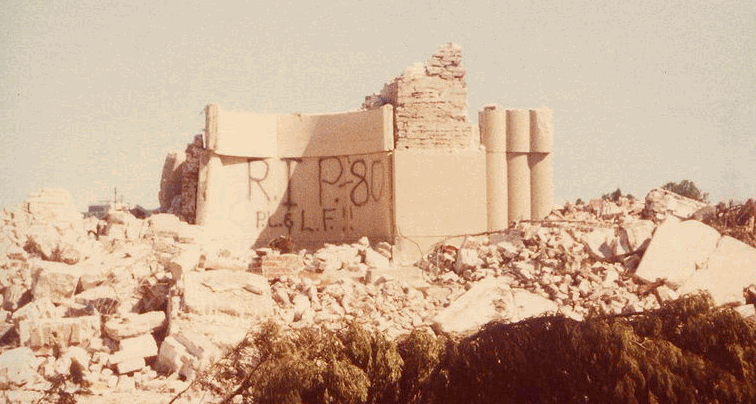 Tulane Stadium was the site of three of the first nine Super Bowls -- Super Bowls IV in 1970, VI in 1972, and IX in 1975.
Super Bowl IX was the final professional league game ever played at the stadium. It would become one of three stadiums which
hosted a Super Bowl and are no longer standing. Tampa Stadium (which hosted two Super Bowls) was demolished in April 1999
and the Orange Bowl (which hosted five Super Bowl games) was demolished in September 2008.
Tulane Stadium was the site of three of the first nine Super Bowls -- Super Bowls IV in 1970, VI in 1972, and IX in 1975.
Super Bowl IX was the final professional league game ever played at the stadium. It would become one of three stadiums which
hosted a Super Bowl and are no longer standing. Tampa Stadium (which hosted two Super Bowls) was demolished in April 1999
and the Orange Bowl (which hosted five Super Bowl games) was demolished in September 2008. 
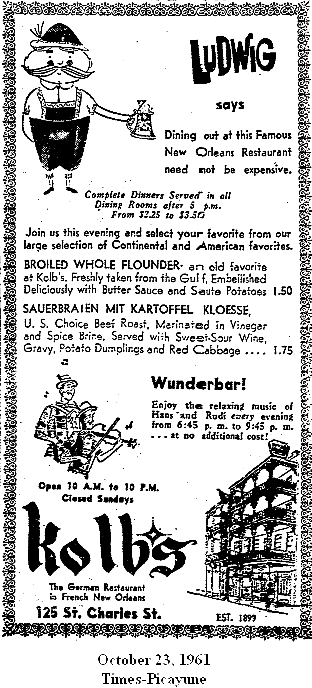
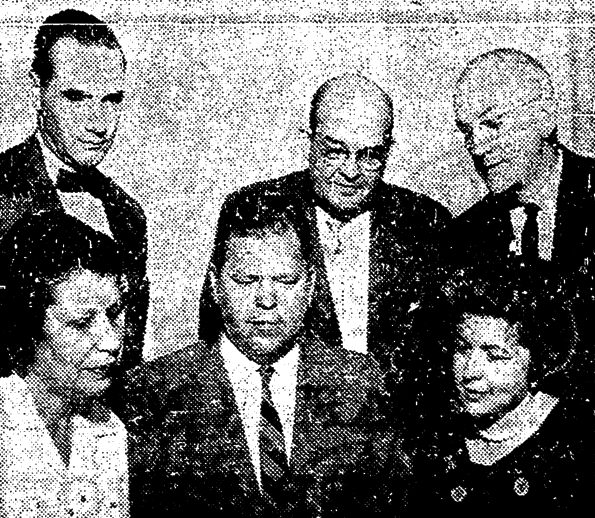
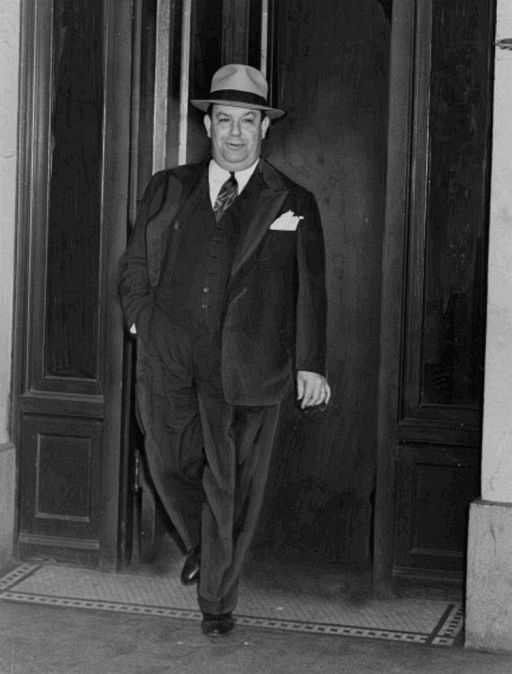 The man behind the construction of the lakefront airport and the massive lakefront "land reclamation" along the
New Orleans lake shore (see October 29) is pictured here walking out of his office alone on October 23, 1941, after learning
of his impending arrest for defrauding his fellow citizens. He had no comments for the the news reporters gathered there but
with a forced smile, said the the photographers, "TAKE A GOOD ONE, BOYS". The mandate for his arrest had been
filed at 11:20 a.m. He was in federal jail by 4:00 that afternoon.
The man behind the construction of the lakefront airport and the massive lakefront "land reclamation" along the
New Orleans lake shore (see October 29) is pictured here walking out of his office alone on October 23, 1941, after learning
of his impending arrest for defrauding his fellow citizens. He had no comments for the the news reporters gathered there but
with a forced smile, said the the photographers, "TAKE A GOOD ONE, BOYS". The mandate for his arrest had been
filed at 11:20 a.m. He was in federal jail by 4:00 that afternoon.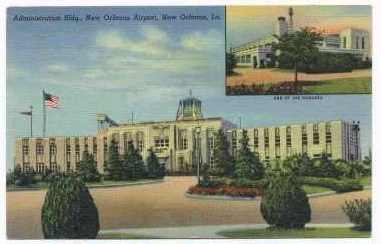 On August 21, 1939, Shusan (and five others) were indicted for mail fraud. He had allegedly been aware of a bribe which
led a levee board member to pursue fellow members not to submit the job for public bid, resulting in Orleans Dredging Company
netting the deal. In 1931 he also allegedly received $130,500 for his part in extorting exorbitant fees from the government,
far in excess of services rendered, in a bond refunding deal and for using the U.S. mail to do so (mail fraud). But all that
seemingly escaped notice for several years until until the indictment.. He was convicted on December 22, 1939 and sentenced
to 30 months in federal prison on January 2, 1940. The U.S. Supreme Court refused to review the case on May 12, 1941
and declined to reconsider its decision on October 3, 1941.
On August 21, 1939, Shusan (and five others) were indicted for mail fraud. He had allegedly been aware of a bribe which
led a levee board member to pursue fellow members not to submit the job for public bid, resulting in Orleans Dredging Company
netting the deal. In 1931 he also allegedly received $130,500 for his part in extorting exorbitant fees from the government,
far in excess of services rendered, in a bond refunding deal and for using the U.S. mail to do so (mail fraud). But all that
seemingly escaped notice for several years until until the indictment.. He was convicted on December 22, 1939 and sentenced
to 30 months in federal prison on January 2, 1940. The U.S. Supreme Court refused to review the case on May 12, 1941
and declined to reconsider its decision on October 3, 1941. 